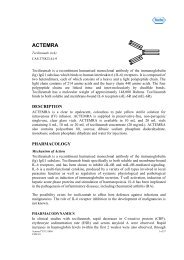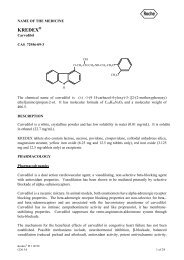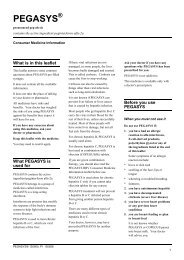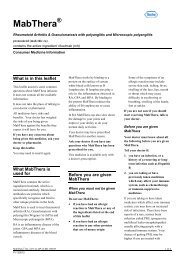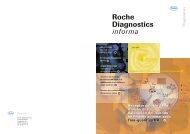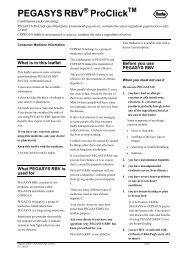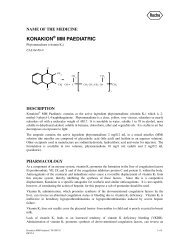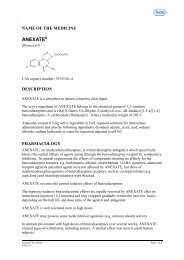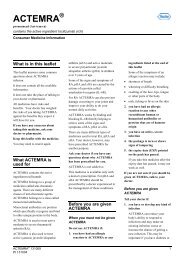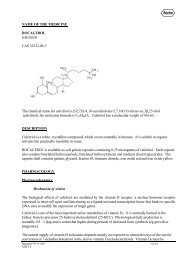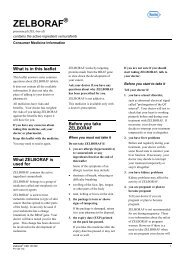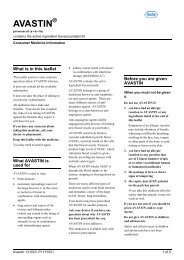Product Information PI - Roche Australia
Product Information PI - Roche Australia
Product Information PI - Roche Australia
Create successful ePaper yourself
Turn your PDF publications into a flip-book with our unique Google optimized e-Paper software.
dosing. Following an oral dose of 75 mg twice daily, the peak concentration (C max ) of the<br />
active metabolite is approximately 350 – 400 ng/mL. At least 75% of an oral dose reaches<br />
the systemic circulation as the active metabolite. Exposure to the pro-drug is less than 5%<br />
relative to the active metabolite. Plasma concentrations of the active metabolite are<br />
unaffected by co-administration with food (see DOSAGE AND ADMINISTRATION).<br />
Distribution<br />
The active metabolite reaches all key sites of influenza infection as shown by studies in the<br />
ferret, rat and rabbit. In these studies, anti-viral concentrations of the active metabolite were<br />
seen in the lung, bronchoalveolar lavage, nasal mucosa, middle ear and trachea, following oral<br />
administration of oseltamivir phosphate.<br />
The mean volume of distribution (V ss ) of the active metabolite is approximately 23 L in<br />
humans. The binding of the active metabolite to human plasma protein is negligible<br />
(approximately 3%).<br />
Metabolism<br />
Oseltamivir is extensively converted to the active metabolite by esterases located<br />
predominantly in the liver. Neither oseltamivir nor the active metabolite is a substrate for, or<br />
an inhibitor of, the major cytochrome P450 isoforms. Thus, interactions mediated by<br />
competition for these enzymes are unlikely.<br />
Elimination<br />
Absorbed oseltamivir is primarily (> 90%) eliminated by conversion to the active metabolite.<br />
Peak plasma concentrations of the active metabolite decline with a half-life of 6 – 10 hours in<br />
most subjects. The active metabolite is not further metabolised and is eliminated entirely<br />
(> 99%) by renal excretion. Renal clearance (18.8 L/h) exceeds glomerular filtration rate (7.5<br />
L/h) indicating that tubular secretion (via the anionic pathway) in addition to glomerular<br />
filtration occurs. Less than 20% of an oral radiolabelled dose is eliminated in faeces.<br />
Special Populations<br />
Renal impairment<br />
Administration of 100 mg of TAMIFLU twice daily, for 5 days, to patients with various<br />
degrees of renal impairment showed that exposure to the active metabolite is inversely<br />
proportional to renal function.<br />
A population pharmacokinetic model describing the impact of creatinine clearance (CrCL) on<br />
oseltamivir and oseltamivir carboxylate pharmacokinetics was developed and qualified for<br />
simulation using 80 subjects with varying degrees of renal function. Subjects had dense<br />
pharmacokinetic profiles and were identified from three clinical studies; a study in subjects<br />
with either normal renal function or mild, moderate or severe renal impairment (WP15648)<br />
and two studies in healthy subjects receiving a range of single (WP15517) or multiple doses<br />
of oseltamivir (WP15525). Simulations were performed and suitable regimens using<br />
Tamiflu <strong>PI</strong> 6 mg/mL oral suspension and capsules 120119 4 of 28<br />
CDS 10.0



